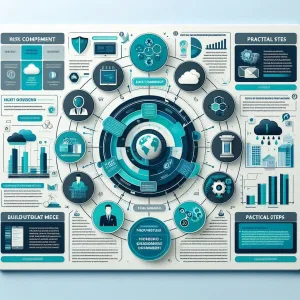In the realm of information technology, IT General Controls (ITGC) are essential policies and procedures that govern the operation of IT systems. They play a critical role in ensuring the confidentiality, integrity, and availability of data and IT systems. ITGCs encompass various functions, including access control, software implementation, data management, and computing operations, which collectively safeguard IT environments against risks such as data breaches, unauthorized access, and operational disruptions [2][5].
As organizations increasingly migrate to cloud environments, the traditional IT landscape has undergone significant transformation. Cloud technology has introduced new paradigms for data storage, processing, and accessibility, which can complicate the enforcement of ITGCs. Unlike conventional on-premises systems, cloud services often involve shared responsibilities between the service provider and the organization, leading to complexities in governance and compliance [3][11]. This shift necessitates a reevaluation of existing ITGC frameworks to address the unique challenges posed by cloud technology.
The adaptation of Information Technology General Controls in cloud settings is not merely a matter of compliance; it is crucial for maintaining operational integrity and information security. As cloud environments can expose organizations to various vulnerabilities, including insider threats and data leaks, it becomes imperative to implement robust ITGCs tailored to these new operational realities. This includes establishing clear guidelines for data access, monitoring user activities, and ensuring that cloud service providers adhere to stringent security standards [10]. By proactively addressing these challenges, organizations can enhance their security posture and ensure that their IT systems operate smoothly and securely in the cloud.
Understanding Cloud Environments
Cloud computing has revolutionized the way organizations manage their IT resources, offering flexibility, scalability, and cost-effectiveness. However, the unique characteristics of cloud environments also present distinct challenges for Information Technology General Controls (ITGC). This section provides a comprehensive overview of the various cloud service models and deployment models, and illustrates how these models impact IT general controls.
Cloud Service Models
Infrastructure as a Service (IaaS):
- IaaS provides virtualized computing resources over the internet. Users can rent IT infrastructure such as servers, storage, and networking on a pay-as-you-go basis.
- Impact on ITGC: Organizations must ensure that controls are in place to manage access to the infrastructure, monitor usage, and secure data stored in the cloud. The shared responsibility model means that while the cloud provider secures the infrastructure, the organization is responsible for securing its applications and data.
Platform as a Service (PaaS):
- PaaS offers a platform allowing customers to develop, run, and manage applications without the complexity of building and maintaining the underlying infrastructure.
- Impact on ITGC: PaaS environments require robust controls around application development and deployment processes. Organizations need to implement controls to ensure that applications are developed securely and that data integrity is maintained throughout the application lifecycle.
Software as a Service (SaaS):
- SaaS delivers software applications over the internet, on a subscription basis. Users access the software via a web browser, eliminating the need for installation and maintenance.
- Impact on ITGC: With SaaS, organizations must focus on data security and compliance, as they often have limited control over the underlying infrastructure. Effective ITGCs should include vendor management practices to assess the security measures of SaaS providers and ensure compliance with relevant regulations.
Cloud Deployment Models
Public Cloud:
- In a public cloud, services are delivered over the internet and shared across multiple organizations. This model is typically cost-effective and scalable.
- Impact on ITGC: The shared nature of public clouds raises concerns about data privacy and security. Organizations must implement stringent access controls and data encryption to protect sensitive information.
Private Cloud:
- A private cloud is dedicated to a single organization, providing greater control over resources and security. It can be hosted on-premises or by a third-party provider.
- Impact on ITGC: While private clouds offer enhanced security, organizations must still establish comprehensive Information Technology General Controls to manage access, monitor usage, and ensure compliance with internal policies and external regulations.
Hybrid Cloud:
- Hybrid clouds combine public and private cloud environments, allowing data and applications to be shared between them. This model offers flexibility and scalability while maintaining control over sensitive data.
- Impact on ITGC: Managing a hybrid cloud requires robust controls to ensure data integrity and security across different environments. Organizations must implement policies that govern data movement and access between public and private clouds.
Community Cloud:
- A community cloud is shared by several organizations with similar interests or requirements, such as compliance or security needs.
- Impact on ITGC: Community clouds necessitate collaborative governance and shared responsibility for security and compliance. Organizations must establish clear ITGCs that address the unique needs of all participants in the community.
Understanding the various cloud service and deployment models is crucial for cloud auditors and IT security professionals. Each model presents unique challenges that impact IT general controls, necessitating tailored strategies to ensure the integrity, confidentiality, and availability of data in cloud environments. By implementing effective ITGCs, organizations can mitigate risks and enhance their overall security posture in the cloud.
Unique Challenges of IT General Controls in Cloud Environments
As organizations increasingly migrate to cloud environments, the landscape of Information Technology General Controls (ITGCs) faces unique challenges that internal auditors and IT security professionals must navigate. The complexities introduced by cloud technology can significantly impact the effectiveness of ITGCs, particularly in multi-tenant environments. Below are some of the key challenges associated with ITGCs in cloud settings:
1. Data Ownership and Control Issues in Multi-Tenant Environments
In cloud computing, multiple customers share the same infrastructure, leading to potential complications regarding data ownership and control. Organizations may struggle to ascertain who has access to their data and how it is managed. This shared environment raises concerns about data segregation and the risk of unauthorized access, making it essential for auditors to evaluate the effectiveness of controls that ensure data integrity and confidentiality. The challenge lies in establishing clear ownership rights and access controls that comply with organizational policies while leveraging the capabilities of cloud services [1].
2. Regulatory Compliance Challenges Due to Varying Jurisdictions
Cloud environments often span multiple jurisdictions, each with its own regulatory requirements. This can create significant compliance challenges, as organizations must ensure that their Information Technology General Controls align with diverse legal frameworks, such as the General Data Protection Regulation (GDPR) in the EU. The complexity of navigating these overlapping regulations can lead to gaps in compliance, particularly when data is stored or processed in different geographical locations. Organizations must develop robust compliance strategies that account for these variations to mitigate the risk of non-compliance and potential legal repercussions [3][10].
3. Difficulty in Ensuring Consistent Application of Controls Across Different Cloud Services
The use of multiple cloud service providers can complicate the consistent application of ITGCs. Each provider may have its own security policies and compliance frameworks, making it challenging for organizations to implement a unified control environment. This inconsistency can lead to vulnerabilities, as different services may not adhere to the same standards of data protection and access control. Internal auditors must assess the effectiveness of controls across various platforms and ensure that there is a cohesive strategy in place to manage compliance and security risks [5][12].
4. Risks Related to Third-Party Vendors and Shared Responsibility Models
The shared responsibility model inherent in cloud computing introduces additional risks associated with third-party vendors. While cloud providers are responsible for the security of the infrastructure, organizations must manage the security of their data and applications. This division of responsibility can lead to misconfigurations and gaps in security if not properly managed. Organizations must conduct thorough due diligence on third-party vendors and establish clear agreements that delineate responsibilities to mitigate risks associated with data breaches and compliance failures [2][8][11].
The transition to cloud environments presents significant challenges for Information Technology General Controls. By understanding and addressing these unique issues, internal auditors and IT security professionals can better safeguard their organizations against potential risks and ensure compliance with regulatory requirements.
Key IT General Controls for Cloud Environments
In the rapidly evolving landscape of cloud technology, organizations face unique challenges that necessitate robust Information Technology General Controls (ITGCs). These controls are essential for ensuring the integrity, confidentiality, and availability of data in cloud environments. Below are critical IT general controls that cloud auditors and IT security professionals should prioritize:
1. Access Management
- Identity and Access Management (IAM): Implementing IAM systems is crucial for controlling who has access to cloud resources. This includes defining user roles, permissions, and ensuring that access is granted based on the principle of least privilege. Regular audits of access rights help to mitigate risks associated with unauthorized access [2].
- Zero Trust Security Principles: Adopting a zero trust model means that no user or device is trusted by default, regardless of whether they are inside or outside the network perimeter. This approach enhances security by requiring continuous verification of user identities and device health [9].
2. Data Integrity
- Data Protection Measures: Ensuring data integrity involves implementing controls that protect data from unauthorized alterations. This can include checksums, hashing, and version control systems that track changes to data over time [2][8].
- Encryption: Utilizing strong encryption protocols, such as AES-256 for data at rest and TLS for data in transit, is vital for safeguarding sensitive information. Encryption not only protects data from unauthorized access but also ensures its integrity during transfer [6].
3. Change Management
- Change Control Processes: Establishing formal change management processes is essential to ensure that any modifications to cloud systems are documented, tested, and approved. This helps prevent unauthorized changes that could compromise system integrity [2][8].
- Automated Change Monitoring: Implementing automated tools to monitor changes in the cloud environment can help detect unauthorized modifications in real-time, allowing for swift remediation [5].
4. Monitoring and Logging
- Continuous Monitoring: Regular monitoring of cloud environments is necessary to identify potential security threats and compliance issues. This includes tracking user activities, access patterns, and system performance [5][8].
- Logging Practices: Maintaining comprehensive logs of all access and changes to cloud resources is critical for auditing and forensic analysis. Effective logging practices help organizations to trace back any incidents and understand the context of security breaches [4].
Addressing the unique challenges posed by cloud technology requires a comprehensive approach to IT general controls. By focusing on access management, data integrity, change management, and robust monitoring and logging practices, organizations can enhance their security posture and ensure compliance in cloud environments. These controls not only protect sensitive data but also foster trust among stakeholders in an increasingly digital world.
Solutions and Best Practices for Implementing IT General Controls
In the rapidly evolving landscape of cloud technology, organizations face unique challenges in maintaining effective Information Technology General Controls. To address these challenges, it is essential to adopt a comprehensive approach that incorporates best practices and actionable strategies. Here are key solutions to enhance IT general controls in cloud environments:
- Implement a Robust Governance Framework: Establishing a governance framework specifically tailored for cloud operations is crucial. This framework should define roles, responsibilities, and processes for managing cloud resources, ensuring compliance with industry standards and regulations. A well-structured governance model helps in aligning cloud strategies with organizational objectives and facilitates better oversight of cloud activities [1].
- Conduct Regular Risk Assessments: Regular risk assessments are vital for identifying vulnerabilities and threats unique to cloud environments. These assessments should focus on the specific risks associated with cloud architectures, such as insecure APIs and data breaches. By continuously evaluating the risk landscape, organizations can proactively address potential issues and adapt their controls accordingly [5][6].
- Adopt Automation Tools: The integration of automation tools can significantly streamline control processes in cloud environments. Automation can help in monitoring compliance, managing access controls, and conducting audits more efficiently. By reducing manual intervention, organizations can minimize human error and enhance the reliability of their IT general controls [4][9].
- Promote Continuous Training and Awareness Programs: Staff training is essential to ensure that employees are aware of cloud-specific risks and best practices. Continuous education programs should be implemented to keep personnel updated on the latest security threats and compliance requirements. This proactive approach fosters a culture of security awareness and empowers employees to recognize and respond to potential risks effectively [8].
By implementing these strategies, organizations can strengthen their IT general controls in cloud environments, ensuring better security and compliance while navigating the complexities of cloud technology.
Future Trends in IT General Controls and Cloud Security
As organizations increasingly migrate to cloud environments, the landscape of Information Technology General Controls is evolving rapidly. This section explores emerging trends and technologies that are shaping the future of IT general controls in the context of cloud security, focusing on three key areas: the impact of artificial intelligence (AI) and machine learning (ML), the evolving regulatory landscape, and the implications of zero-trust security models.
Impact of Artificial Intelligence and Machine Learning on Control Automation
The integration of AI and ML into IT general controls is revolutionizing how organizations manage security and compliance in cloud environments. These technologies enable:
- Enhanced Threat Detection: AI and ML algorithms can analyze vast amounts of data in real-time, identifying anomalies and potential threats more quickly and accurately than traditional methods. This capability allows for proactive risk management and faster incident response, which is crucial in dynamic cloud environments [5].
- Automation of Controls: Automation powered by AI can streamline control processes, reducing the manual effort required for monitoring and compliance. This not only increases efficiency but also minimizes human error, which is a significant risk factor in IT controls [12].
- Predictive Analytics: AI-driven predictive analytics can forecast potential security incidents based on historical data, enabling organizations to implement preventive measures before issues arise [11].
Evolving Landscape of Regulations and Compliance Requirements
As cloud technology continues to advance, so too does the regulatory landscape. Organizations must navigate a complex web of compliance requirements that are constantly changing. Key considerations include:
- Increased Regulatory Scrutiny: With the rise of cloud computing, regulators are paying closer attention to data privacy and security. Organizations must ensure that their IT general controls align with regulations such as GDPR, HIPAA, and others that govern data protection in cloud environments [4].
- Adaptation to New Standards: Emerging standards and frameworks, such as those related to cloud security and data governance, require organizations to adapt their IT general controls accordingly. This may involve implementing new technologies or processes to meet compliance demands.
- Cross-Border Compliance Challenges: As businesses operate globally, they face the challenge of complying with varying regulations across different jurisdictions. This complexity necessitates robust IT general controls that can accommodate diverse regulatory requirements.
Implications of Zero-Trust Security Models in Cloud Environments
The adoption of zero-trust security models is becoming increasingly prevalent in cloud environments, fundamentally altering the approach to IT general controls. Key implications include:
- Continuous Verification: Zero-trust principles emphasize the need for continuous verification of users and devices, rather than assuming trust based on location or network. This shift requires organizations to implement more stringent access controls and monitoring mechanisms [2].
- Micro-Segmentation: By segmenting cloud environments into smaller, isolated zones, organizations can limit the potential impact of a security breach. This approach necessitates robust IT general controls to manage access and monitor activity within each segment [9].
- Integration with AI and ML: The zero-trust model can be enhanced through the integration of AI and ML, which can provide real-time insights and automate responses to security incidents. This synergy between zero-trust principles and advanced technologies is crucial for maintaining a secure cloud environment [5][11].
The future of IT general controls in cloud environments is being shaped by the integration of AI and ML, the evolving regulatory landscape, and the adoption of zero-trust security models. Cloud auditors and IT security professionals must stay informed about these trends to effectively manage risks and ensure compliance in an increasingly complex digital landscape.
Conclusion
In the rapidly evolving landscape of cloud technology, the implementation of Information Technology General Controls (ITGC) presents unique challenges that require careful consideration and strategic solutions. As organizations increasingly migrate to cloud environments, they face issues such as lack of visibility and tracking, misconfigurations, and the complexities of managing multi-cloud setups. These challenges can compromise the confidentiality, integrity, and availability of data, making it imperative for cloud auditors and IT security professionals to adapt their control frameworks accordingly.
To address these challenges, organizations must adopt a proactive approach that includes:
- Regular Access Reviews: Ensuring that user access controls are authorized and revalidated frequently helps mitigate risks associated with unauthorized access and insider threats [9].
- Centralized Logging and Analysis: Integrating tools for centralized logging enhances visibility across hybrid or multi-cloud environments, allowing for better monitoring and response to potential security incidents [13].
- Adopting Cloud Security Frameworks: Utilizing established cloud security frameworks provides guidance on implementing effective controls tailored to cloud environments, ensuring alignment with organizational security policies [12].
The importance of continuous improvement and adaptation in cloud auditing cannot be overstated. As cyber threats evolve and new technologies emerge, organizations must remain vigilant and responsive to changes in the cloud landscape. This involves not only updating existing controls but also fostering a culture of security awareness and risk management throughout the organization.
Finally, it is crucial for cloud auditors and IT security professionals to stay informed about advancements in cloud technologies and the latest control frameworks. Engaging with industry resources, attending relevant training, and participating in professional networks can provide valuable insights and keep practitioners ahead of emerging challenges.
By embracing these strategies, organizations can enhance their IT general controls in cloud environments, ultimately leading to a more secure and resilient IT infrastructure.
Find out more about Shaun Stoltz https://www.shaunstoltz.com/about/
This post was written by an AI and reviewed/edited by a human.



